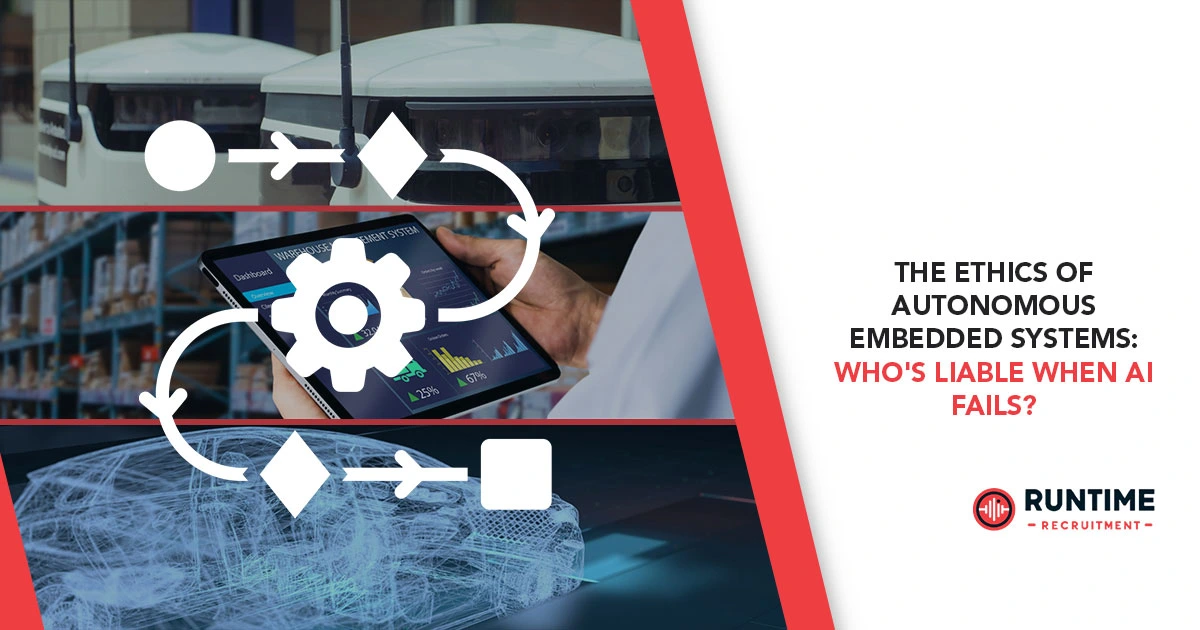As embedded engineers, we’re at the forefront of a technological revolution. We’re the architects building the foundation for a world where devices think, act, and make decisions on their own. Autonomous embedded systems, from self-driving cars to robotic surgical assistants, are no longer science fiction. They’re a tangible reality, and with this reality comes an unprecedented ethical and legal challenge: who’s liable when AI fails? This isn’t just a philosophical question; it’s a critical design and business consideration that will define our professional landscape for decades to come.
The New Frontier: Why AI Liability is Different
The traditional product liability framework, which has been the cornerstone of consumer protection for decades, is ill-equipped to handle the complexities of AI. In a traditional product, a defect is a manufacturing flaw or a design error that can be traced back to a specific human decision. If a car’s brakes fail due to a faulty weld, the manufacturer is liable. Simple. But what about a self-driving car that causes an accident because its machine learning model made an unpredictable decision based on novel data it encountered on the road?
The “black box” nature of many deep learning models makes it difficult, if not impossible, to trace the exact cause of a failure. The system’s behavior isn’t governed by a deterministic set of rules we can debug in a traditional sense. Instead, it’s a product of billions of data points and a learning process that evolves over time. This creates a significant legal and ethical chasm:
- Causation is Opaque: Pinpointing the exact cause of an AI-driven failure can be incredibly challenging. Was it a flaw in the training data? A subtle bug in the inference engine? An unexpected interaction with the physical environment? Or was it an inherent, and perhaps unpreventable, limitation of the algorithm itself?
- Multiple Stakeholders, Unclear Responsibility: A single autonomous system involves a complex supply chain. There’s the company that develops the core AI algorithm, the semiconductor manufacturer, the systems integrator who builds the embedded hardware, the OEM that puts it all together, and the end-user. If the system fails, who’s at fault? Is it the software developer for a flawed algorithm, the hardware designer for a component that couldn’t handle a specific edge case, or the end-user who didn’t follow a warning prompt?
- Evolving Behavior: Unlike traditional software, autonomous systems, especially those with continuous learning capabilities, can change their behavior post-deployment. An AI that performs perfectly in a test environment could develop an unforeseen bug or bias in the wild. This challenges the concept of a product being “defective” at the time of sale, which is a key tenet of product liability law.
A Breakdown of Potential Liable Parties
When an AI-driven system causes harm, the legal system will likely scrutinize several potential parties. Understanding these roles is crucial for us as embedded engineers to understand our own responsibilities and risks.
The Developer/Programmer
This is where we, as embedded engineers, often find ourselves. Our work on the firmware, the operating system, and the low-level drivers that interface with the hardware is critical. While a legal challenge might not target a single line of C code, it could focus on the overall design and implementation of the system.
- Negligence: A key legal standard is negligence. Did we, as engineers, exercise a “reasonable duty of care” in our design and testing? This could involve proving we followed industry best practices, conducted thorough risk assessments, and implemented robust fail-safes. For example, if a medical device’s AI-powered diagnostic tool fails, was the engineer negligent by not incorporating a human-in-the-loop oversight mechanism?
- Algorithmic Bias: A particularly thorny issue is algorithmic bias. If a facial recognition system’s AI is trained on a dataset that under-represents certain demographics, it may fail to identify individuals from those groups, leading to discriminatory outcomes. If a recruitment AI systematically penalizes applicants with non-traditional career paths, is the developer who built the system responsible for that outcome? The ethics of data selection and model training are now part of our professional responsibility.
The Manufacturer/OEM
The company that manufactures the final product is a primary target for liability claims. This is because they’re the ones who put the product on the market and are responsible for its overall safety and functionality.
- Product Liability: Under product liability law, a manufacturer can be held strictly liable for a defective product that causes harm, regardless of fault. The question then becomes, what constitutes a “defect” in an autonomous system? Is a “defect” a flaw in the physical hardware, or can it be a flaw in the software’s decision-making process? This is where legal frameworks are still catching up. The EU’s proposed AI Act and updated Product Liability Directive are attempting to close this gap by creating a strict liability regime for high-risk AI systems.
- Duty to Warn: A manufacturer also has a duty to warn users of a product’s potential dangers. In the context of AI, this might mean clearly outlining the limitations of an autonomous system. For example, a self-driving car’s user manual must explicitly state the conditions under which the driver must take control. Failure to provide clear and adequate warnings could be a basis for liability.
Third-Party Suppliers
The embedded systems we work on are rarely built in a vacuum. We rely on a vast ecosystem of third-party suppliers for everything from custom silicon and sensors to open-source libraries and machine learning frameworks. If a component from a third party fails, is the OEM or the supplier liable?
- Component Failure: If a sensor from a third-party supplier fails to provide accurate data to the AI, and this leads to an accident, the supplier of that component could be held liable. The challenge is proving that the component was defective and not that the system’s software was unable to handle the faulty data.
- Contractual Agreements: In the B2B world, these liability issues are often addressed through complex contractual agreements. These contracts define who is responsible for what and how liability is shared. However, these agreements don’t protect us from external liability to the end-user.
The End-User
While less common, the end-user can also be found liable, especially if they misuse the system or ignore its warnings. For example, if a self-driving car instructs the driver to take control, and they fail to do so, they could be held responsible for the resulting accident. As embedded engineers, we must design systems with clear, unambiguous user interfaces and robust prompts to minimize the likelihood of user error.
Case Studies and Evolving Legal Frameworks
The legal landscape is evolving rapidly to address these new challenges. Several high-profile incidents have brought the issue of AI liability to the forefront.
- The Uber Self-Driving Car Accident: In 2018, an autonomous Uber vehicle struck and killed a pedestrian. The NTSB investigation revealed a confluence of factors, including the vehicle’s software being unable to correctly classify the pedestrian as a human and a subsequent decision to not apply the brakes. This case highlighted the immense complexity of assigning blame and the inadequacies of existing laws. It led to questions about the manufacturer’s responsibility for the AI’s decision-making, the developer’s duty to account for all possible scenarios, and the need for stricter safety regulations.
- AI in Healthcare: In the medical field, a misdiagnosis by an AI-powered diagnostic tool could have life-altering consequences. While an AI might be more accurate than a human doctor in some cases, the legal system is still grappling with who is responsible when it gets it wrong. Is it the hospital for using the tool? The doctor who trusted the diagnosis? The developer who designed the algorithm? This is an area where a human-in-the-loop approach is not just a good idea, but a moral and legal imperative.
To address these issues, regulatory bodies are stepping in. The European Union’s AI Act is a landmark piece of legislation that adopts a risk-based approach. It classifies AI systems into categories: unacceptable risk, high-risk, limited risk, and minimal risk. For high-risk systems, such as those in healthcare, transportation, and critical infrastructure, the Act imposes strict obligations, including:
- Data Governance: Ensuring high-quality datasets to minimize bias and discriminatory outcomes.
- Technical Documentation: Maintaining detailed records of how the system was developed and trained.
- Human Oversight: Designing systems to be supervised by humans.
- Conformity Assessments: Requiring high-risk systems to undergo a rigorous conformity assessment before being placed on the market.
This legislation signals a shift towards a more proactive, rather than reactive, approach to AI safety. It’s a clear message to embedded engineers: the days of “move fast and break things” are over when it comes to autonomous, safety-critical systems.
The Call to Action for Embedded Engineers 👨💻
As the architects of this new world, we have a unique responsibility. The decisions we make today—the algorithms we choose, the data we use, the fail-safes we implement—will directly impact the safety and ethical integrity of the future. We can’t afford to be just technicians; we must be ethical custodians.
- Embrace the “Ethical by Design” Philosophy: Build ethical considerations into your design process from the very beginning. This means thinking about potential harms, biases, and unintended consequences before you write a single line of code. Conduct thorough risk assessments and build in safety mechanisms, such as robust logging, clear error handling, and human-in-the-loop controls.
- Champion Transparency and Explainability: Where possible, push for AI models that are more explainable (XAI). While not always feasible for complex systems, striving for transparency can help in debugging and, in the event of a failure, can provide crucial evidence of your due diligence. Document everything, from your design choices to your test procedures.
- Stay Informed and Engage with Policy: The regulatory landscape is a living, breathing thing. Keep up with new standards and proposed legislation, like the EU’s AI Act. Get involved in industry groups and professional organizations that are helping to shape these policies. Your perspective as a hands-on engineer is invaluable.
- Advocate for Strong Safety Standards: Push your teams and companies to adopt and adhere to rigorous safety standards. Standards like ISO 26262 for automotive systems and IEC 61508 for functional safety are more relevant than ever. Compliance isn’t just about avoiding legal trouble; it’s about building trustworthy, reliable products.
The work we do is more than just a job; it’s a craft with profound societal implications. We are building the nervous system of the future, and we must do so with integrity and foresight. The question of “who’s liable?” is a symptom of a larger challenge: creating a framework of trust for a new generation of intelligent machines. It’s a challenge that, as embedded engineers, we are uniquely positioned to solve.
Do you feel like you’re an ethical engineer building the future, but your current role doesn’t align with your values? Or maybe you’re a hiring manager struggling to find engineers who truly understand the critical importance of AI ethics and safety.
Don’t let the future pass you by. Connect with RunTime Recruitment. We specialize in placing embedded engineers who aren’t just technically brilliant, but also committed to building the future responsibly. We understand the nuances of this industry and connect the right talent with the right opportunities. Let’s build a safer, more ethical future together.









